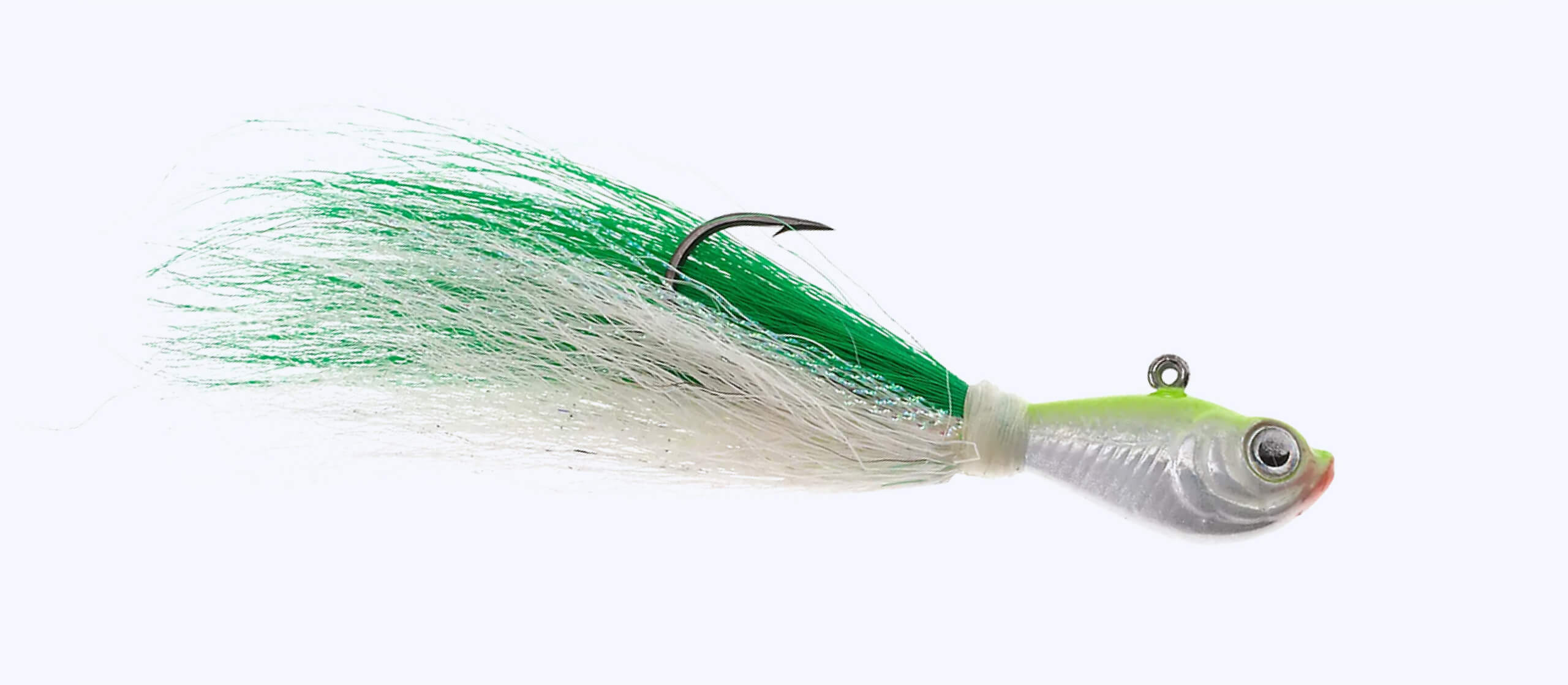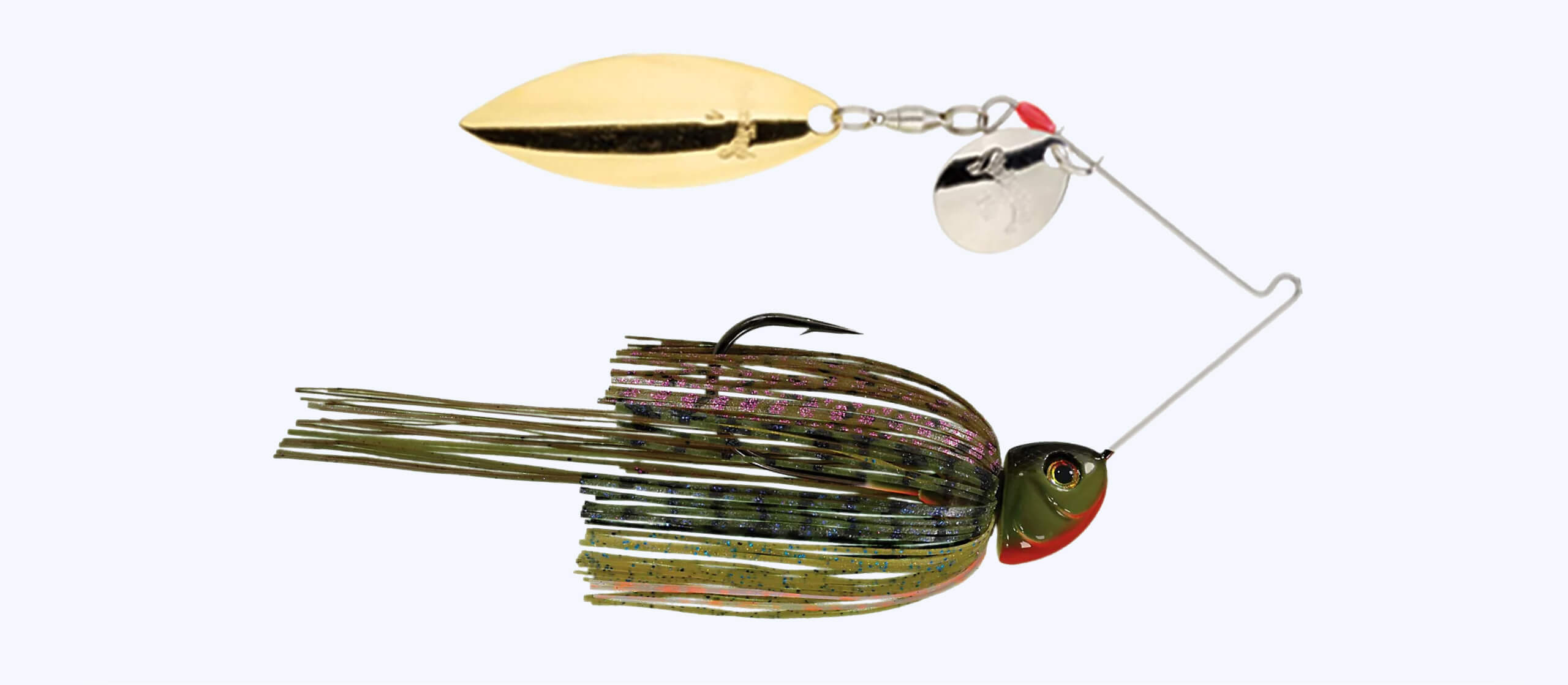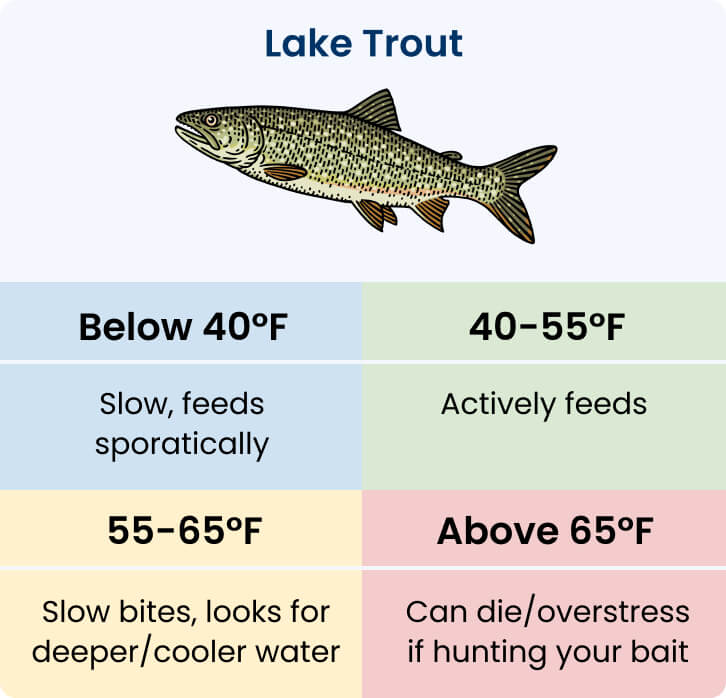Best Lake Trout Baits & Lures to Catch Your Next Slab

You're standing at the edge of a tranquil lake. Suddenly, you feel a tug on your fishing rod. You start reeling in your line, and there it is — a gorgeous Lake Trout, shimmering in the sunlight!
Lake Trout are notoriously picky when it comes to what they eat. So leaving for a day of fishing with the right baits and lures in your box is essential if you want to catch these tasty fish.
In this article, you'll find more than a simple list of what we recommend. Our expert dive deep into what it takes to understand this elusive fish:
Key Takeaways
- What Are Lake Trout? — Lake Trout are a beloved, common freshwater fish found in rivers and lakes around the northern United States and Canada.
- What Do Lake Trout Eat? — As top predators in the food chain, Lake Trout eat a range of creatures, including plankton, fish, insects, larvae, and small invertebrates.
- Best Live Bait for Lake Trout — You can catch Lake Trout using either live or dead baitfish — specifically those between 3 and 5 inches.
- Best Artificial Lures for Lake Trout — The most effective types are jigs, crankbaits, spoons, spinners, and soft plastics.
- What Lake Trout Bait to Use by Season — The effectiveness of different bait types can vary depending on the season, water temperature, and feeding patterns of the fish.
- Ideal Lake Trout Seasonal Fishing Water Temperatures — Water temperature is important for Lake Trout anglers to consider! Too cold, and the fish get slow and feed irregularly. Too warm, and they can overstress and even possibly die.
Complete Guide to the Best Lake Trout Baits & Lures
Lake Trout are commonly found in freshwater rivers and deep lakes in the northern U.S. They can be found from Alaska to Nova Scotia and in the Great Lakes.
What Are Lake Trout?

Lake Trout are the largest member of the char family. But you may have heard their other names: the Mackinaw, lake char, togue, or Namaycush. Lake Trout need cool water — preferably around 53°F. You'll often find them in large, deep lakes near fishing ledges, drop-offs, and shelves. They are top predators and key to maintaining the necessary balance in the food chain.
What Do Lake Trout Eat?
Lake Trout's preferred diet often depends on the other species available in their environment.
- Younger Lake Trout Diet: When they're younger they tend to eat plankton and insects.
- Older Lake Trout Diet: When they're older they eat more bait fish like minnows, alewives, and ciscoes.
If there aren't sufficient food sources in their environment, Lake Trout may resort to cannibalism. If there is an adequate baitfish population, the rates of cannibalism among Lake Trout are nearly nonexistent.
Best Live Bait for Lake Trout
Smaller baits are easier to keep alive than larger baits but won't be as active, which allows for more control and a better presentation. Larger baits are harder to keep alive but are usually more active than smaller bait.
| Best Lake Trout Baits & Lures Guide | ||||
|---|---|---|---|---|
| Name | Time Most Active | Spring / Fall Depth | Summer / Winter Depth | Best Lure To Mimic Bait |
| Baitfish | Sunrise or sunset | Shallow | Deep | Crankbait |
| Minnows | Daytime | Shallow | Shallow | Spinnerbait |
| Alewives | Daytime | Deep | Shallow | Spoons |
| Ciscoes | Twilight | Shallow | Deep | Spinners, jigs |
| Gold Shiners | Daytime | Shallow | Shallow | Jerkbait |
| Nightcrawlers | Night | Shallow | Shallow | Soft plastics |
| Salmon Eggs | Daytime | Deep | Shallow | Soft plastics |
Expert Tip:
The bigger the Lake Trout, the larger the baits and lures they generally command.
Types of Baitfish + Bait for Lake Trout

Minnows are one of the most preferred live baits for targeting Lake Trout. They're actually one of their main food sources. Use a spinnerbait or swimbait to mimic their motions and bring Lake Trout your way!

Using small live bait fish like alewives is a tried-and-true technique for catching Lake Trout.

Cisco baitfish are also a natural food source for Lake Trout. You'll find them in the Great Lakes and nearby water systems. Using a crankbait or spinnerbait to mimic the actions of cisco is an effective way to attract Lake Trout.

If you're looking to target trophy Lake Trouts, larger baits like golden shiners can often yield fantastic results! Shiners are a natural food source for Lake Trout and serve as a good method to attract them.

Nightcrawlers are worms that are often successful at attracting many species of fish — including trout, bass, and walleye.

Salmon eggs are another versatile bait that can attract a variety of fish. But know that if you plan to use fish eggs for bait, you'll need a sack or roe bag so they won't float away before they do their job.
Best Artificial Lures for Lake Trout
Despite the success trout anglers have with bait, using artificial lures is a great alternative when live bait is hard to come by. Always choose your lure to mimic the size and color of the natural food sources in the area you're fishing. Lures can be presented in different ways like casting, trolling, and jigging.
Best Lake Trout Spoon: Nichols Lures 5” Lake Fork Flutter Spoon

Why We Chose It: Flashy, erratic movement and large size are tailor-made for larger lakers.
How to Use This: It can be trolled behind a boat, fished vertically with rising and lowering of the rod tip, horizontally along the bottom, or simply drifting behind the boat.
Key Features:
- Owner ST-36 treble hook with performance flashabou, Spro power swivels, and Worth split rings
- Eye-catching finish helps attract a variety of fish
Best Lake Trout Jigging Lure: SPRO® Prime Bucktail 3/4 oz Jig

Why We Chose It: Jigs are great for going after trout when the bite gets slow, and they can get down to deep water fast.
How to Use This: Find schools of baitfish or spots of structure and hop it across the bottom with sharp jerks of the rod, or swim it slowly through the baitfish or structure, pausing to let it fall every so often.
Key Features:
- Realistic head, bulging eyes, and a holographic finish
- Lifelike gliding motion
- Sharp, size 5/0 Gamakatsu single hook
Best Lake Trout Spinner: Strike King Hack Attack 1/2 oz Heavy Cover Spinnerbait

Why We Chose It: Big spinnerbaits are great for mimicking large baitfish that Lake Trout really key in on, and the flash of the blades ensures they get noticed.
How to Use This: Cast it out as far as you can in deep water, let it sink to the bottom, then slowly reel it back in bumping into the bottom and structure as often as you can. Give it erratic jerks from time to time to imitate frightened flight.
Key Features:
- Designed with the help of Bassmaster Elite Series veteran, Greg Hackney
- Gamakatsu extra-strong Siwash hook designed to stay closed
- Contoured head design helps the lure deflect off cover
Best Lake Trout Soft Plastic: Megabass MAGDRAFT 6" TrebleBait

Why We Chose It: Soft plastic swim baits are extremely versatile and proven producers.
How to Use This: They can be trolled deep when paired with a heavyweight, cast out and retrieved at various speeds, or jigged horizontally across the bottom. Mix up your presentation for the best results.
Key Features:
- Designed for hard-thumping action with a medium-slow to medium retrieve
- Tail sends vibrations throughout the body to activate the lateral line of predators
- Mag-hold system secures the treble hook alongside the belly via an internal magnet
What Lake Trout Bait to Use by Season
Understanding what Lake Trout bait to use by season can significantly improve your chances of catching these elusive and prized fish. Below, we show you a brief overview of the best bait options for Lake Trout fishing in different seasons.
| Seasonal Lake Trout Bait Guide | ||||
|---|---|---|---|---|
| Season | Best Months To Fish | Time of Day Most Active | Best Bait To Use | Typical Fish Feeding Behavior |
| Spring | March, April, May | Early morning or dusk | Crankbaits, spoons | Most actively feeding when bugs are active (early morning or late evening) |
| Summer | June through August | Dawn to noon | Spoons | Feed mainly from dawn until noon |
| Fall | September, October | Early morning or dusk | Live bait, crankbaits | Fish move throughout the lake, can be caught during the day |
| Winter | December and January | Early morning or late afternoon | Tubes, soft plastics | Often stay a little higher in the water column; feed in depths between 20 and 60 feet |
As the water temperature changes, Lake Trout behaviors change as well and experienced anglers will take advantage of these changes to successfully target them. The preferred temperature for Lake Trout is typically between 40-50°F — though they can spend time outside of this range when necessary.
Ideal Lake Trout Seasonal Fishing Water Temperatures

- Below 40°F — Lake Trout are slow and feed intermittently in this temperature range.
- 40-55°F — Lake Trout actively feed in this temperature range.
- 55-65°F — Lake Trout bites will slow as they begin looking for and moving to cooler, deeper water.
- Above 65°F — You should stop fishing for Lake Trout in these water temperatures. Doing so runs the risk of killing them or overstressing them.
Spring
In early spring, trout feed for longer and in more parts of the lake. Your chances of successfully targeting a Lake Trout will likely increase during this season! They tend to stay in the shallows in early spring when the water is still cool but will move to deeper basins as spring turns into summer.
Expert Tip:
Lake Trout typically avoid bright light, so overcast spring days make great fishing conditions.
Summer
Fishing for Lake Trout is generally best in the summer months of June through August. Fish congregate in the deepwater basins and can be targeted easily. They go deeper in the lake to about the 53°F thermal layer.
Expert Tip:
In the summer months, Lake Trout typically eat from dawn until noon.
Fall
Lake Trout congregate along rocky shorelines and shoals, which makes it easier for you to target them in shallow water. In the fall, Lake Trout begin spawning as early as September in parts of Canada. However, in some warmer parts of the northern United States, they won't spawn until as late as November. Find them spawning in shallow water during the night.
Expert Tip:
Fall is when Lake Trout are stocking up on baitfish for the winter. Using live bait like minnows, worms, or other small baitfish can be very effective!
Winter
Lake Trout love cold, oxygen-rich water. They do stay active in winter if the temperature isn't too frigid. In colder months, you'll find Lake Trout closer to the shore and the surface because the water at the bottom is actually too cold for them.
Expert Tip:
Using artificial lures like tubes, spoons, and soft plastics can be effective in winter.
Have Fun Out There!
Put your new knowledge to the test! Stock up on baits and lures that you can use to target Lake Trout from Academy Sports + Outdoors. Learn all about other species of fish and the baits and lures that work best for each of them:
- Looking to catch a prized hawg? Learn all about the best baits and lures for bass!
- Want to brush up on walleyes? Use these best baits and lures before you head out.
- Excited for a tasty challenge? Catch your next catfish with these best baits and lures.
- Bring home the biggest red drum of the day! Use these best baits and lures for redfish.
- Reel in a nice speckled fish. Catch your next crappie with these baits and lures.
- Cast out the right tackle for your next striper. Learn all about the best striped bass baits and lures.
- Ready to catch your next rainbow trout? Don’t forget these best baits and lures!


